Eliminating Moisture in Walls
Words: Dan Kamys
Air Barriers
By Brett Martin
[caption id="attachment_9925" align="alignright" width="300"]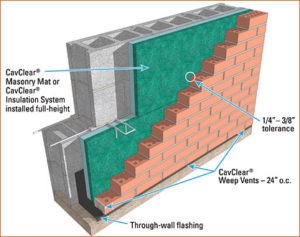 Shown is a diagram of Archovations, Inc.'s CavClear.[/caption]
Shown is a diagram of Archovations, Inc.'s CavClear.[/caption]
Air barrier systems are essential for getting rid of moisture that gets behind masonry walls. Typically installed on the outward-facing side of a structural wall, air barriers help keep water out of the building envelope, says Gary Henry, business communication specialist for PROSOCO Inc. in Lawrence, Kan.
"Water worms its way in through failed mortar joints, gaps where the wall meets the roof and foundation, and from wind-driven rain," Henry says. "On warm, humid days, warm, moist air can find its way in through those same pathways, until it drops its moisture on cold pipes or on drywall cooled by air conditioning. [In] hot or cold weather, wet walls have reduced R-value, which kicks up heating and cooling costs. And, of course, wet walls are susceptible to mold."
[caption id="attachment_9926" align="alignleft" width="300"]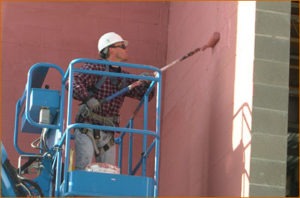 Tim Crookshanks, Western Waterproofing, rolls on a water-based, fluid-applied air barrier at the new H & R Block Building in Kansas City, Mo. Photo courtesy of PROSOCO[/caption]
Tim Crookshanks, Western Waterproofing, rolls on a water-based, fluid-applied air barrier at the new H & R Block Building in Kansas City, Mo. Photo courtesy of PROSOCO[/caption]
Addressing moisture problems
Insulation often is placed over an air barrier to make buildings more energy efficient, says Dave Polk, president of Epro Services Inc. in Derby, Kan. In this construction method, the air barrier has to be non-permeable to keep any moisture from passing through the masonry wall to the building's interior.
"The idea is make the building water and air tight," Polk says.
When insulation is placed inside the masonry wall, the air barrier has to be permeable to allow moisture vapor to pass through it, he says.
"The [goal] is to keep moisture out of the building, but if it gets in, the air barrier allows moisture to get out in the form of vapor," he says. "You want to have a permeable, or what we call 'breathable,' barrier, so condensation will [pass as] vapor through it to the outside of the building."
Once moisture gets inside a wall and reaches the plywood sheathing, the moisture will go through seams where the plywood isn't tight, get between the sheathing and the exterior wall, and will then find weep holes and failed mortar joints to get outside, PROSOCO's Henry says.
[caption id="attachment_9927" align="alignright" width="300"]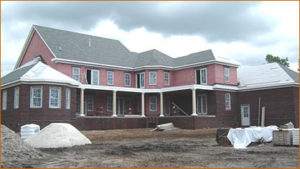 Rain clouds over this partially completed luxury residence in Myrtle Beach, S.C., underscore the importance of air barriers that are durable enough to act as secondary drainage planes. Though the masonry veneer isn't yet up on the second story, the walls are protected by a water-based, fluid-applied air- and water-resistive barrier. Photo courtesy of PROSOCO[/caption]
Rain clouds over this partially completed luxury residence in Myrtle Beach, S.C., underscore the importance of air barriers that are durable enough to act as secondary drainage planes. Though the masonry veneer isn't yet up on the second story, the walls are protected by a water-based, fluid-applied air- and water-resistive barrier. Photo courtesy of PROSOCO[/caption]
"It's not a straight path," he says. "That warm, moist air passing from inside to outside through that torturous little path is letting energy escape. You're letting your energy dollars escape just like if you left a door or window open."
Condensation can also create problems, Henry explains. As warm, humid air leaks through gaps in walls into the wall cavities and meetsÊcold surfaces chilled byÊthe cold outsideÊair, condensation occurs, just like on a glass of ice water in a warm room./p>
"That warm moist air is going to try to find its way to the cold dry air," Henry says. "It will try to get out any hole, like penetrations in the wall."
Air barriers stop that air from moving through the wall cavity, he says.
[caption id="attachment_9928" align="alignright" width="300"]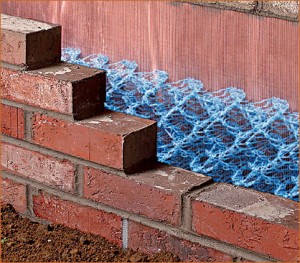 Shown is non-asphaltic copper flashing. These aren't the air barrier systems themselves, but flashing that is used with the air barriers. Photo courtesy of Advanced Building Products[/caption]
Shown is non-asphaltic copper flashing. These aren't the air barrier systems themselves, but flashing that is used with the air barriers. Photo courtesy of Advanced Building Products[/caption]
Managing moisture with air barriers
Air barriers need four things to be effective, otherwise they can make the moisture condition worse, Henry says. They have to be continuous, so air doesn't escape at seams; durable so they stay in place until the brick is installed; breathable so vapor can pass through; and structural so they adhere to the sheathing and can't detach from it.
Epro Services has an air barrier membrane called Ecoflex that can be rolled or sprayed onto buildings. The barrier is placed in wall cavities of commercial buildings, like schools, between the CMU and the brick façade, Polk says.
Ecoflex is self-sealing and adheres to almost any substrate, including damp block, to prevent air leakage. It also seals leaks caused by penetrations in the wall and cracking due to building movement and shrinkage, Polk says. Ecoflex comes in both a permeable and non-permeable formulation.
Hudson, Wis.-based Archovations Inc. makesÊair space maintenance and drainage materials, called CavClear, that help manage moisture in masonry construction, according to Sarah Atkins, company president.
[caption id="attachment_9929" align="alignleft" width="300"]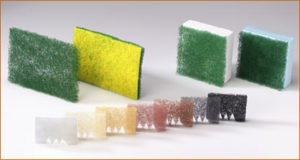 CavClear is made with a non-woven plastic mesh and is designed to have water drain through, not absorb. Photo courtesy of CavClear[/caption]
CavClear is made with a non-woven plastic mesh and is designed to have water drain through, not absorb. Photo courtesy of CavClear[/caption]
"Our products are made withÊa non-woven plastic mesh. They're designed to have water drain through them, not absorb the water," Atkins says, explaining that CavClear spreads out moisture along the fibers. "Because you've now increased the surface area of the moisture, it's going to dry faster."
CavClear prevents excess mortar from blocking weep holes, allowing moisture to pass through the wall properly, she says. It also provides protection against mold, mildew and other moisture-related problems, and it can be used with other air barriers.
"CavClear lets air and water flow through the air space for good drainage and ventilation," Atkins says. "If you're building with brick, a product like ours is going to provide ventilation to the air space behind it and prevent moisture-related failures."
[caption id="attachment_9930" align="alignright" width="300"]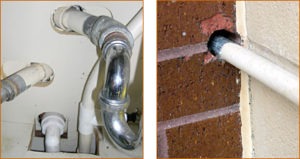 (Left) Under a sink, pipes penetrate the wall assembly. Even though the gaps seem tiny, for air they are a super-highway. If there is a pathway to the outdoors, expensively conditioned air will blow out just the same as if you left a door or window open. Air barriers block those pathways. (Right) This opening in the masonry veneer lets warm moist air into the building envelope. If it finds its way through the structural wall, there is danger of condensation in the cooler recesses of the wall assembly. Condensation creates conditions for mold and other wall-component deterioration. Air barriers stop the air flow at the structural walls. Photos courtesy of PROSOCO[/caption]
(Left) Under a sink, pipes penetrate the wall assembly. Even though the gaps seem tiny, for air they are a super-highway. If there is a pathway to the outdoors, expensively conditioned air will blow out just the same as if you left a door or window open. Air barriers block those pathways. (Right) This opening in the masonry veneer lets warm moist air into the building envelope. If it finds its way through the structural wall, there is danger of condensation in the cooler recesses of the wall assembly. Condensation creates conditions for mold and other wall-component deterioration. Air barriers stop the air flow at the structural walls. Photos courtesy of PROSOCO[/caption]
Understanding and installing air barriers
Air barrier installation is typically straightforward, such as rolling or spraying the barrier onto the wall, so masonry contractors can install it while building masonry walls.
"The masonry contractor is typically the installer of air barriers since the mason is erecting the block walls, then they're applying the brick façade," Polk says.
Even if masonry contractors don't apply the air barriers, they need to understand how the systems work, Henry says.
"It's important for a masonry contractor to be well educated about all aspects of the wall," Henry says. "The masonry contractor has to know what's going on with the wall, so he knows how to respond if there's a problem."
[caption id="attachment_9931" align="alignleft" width="300"]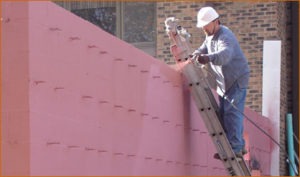 Photo courtesy of PROSOCO[/caption]
Photo courtesy of PROSOCO[/caption]
For example, if he notices the air barrier coming loose before he starts laying brick, he'll know there's a problem that can lead to moisture and mold.
"The masonry contractor has to realize he could be one of the first people who gets blamed if there's a problem, even if he had nothing to do with it," Henry says. "He could fairly quickly put investigators right, but who needs to spend time doing that to begin with?"
If the masonry contractor spots a problem, he can inform the general contractor, he adds. "Like it or not, the masonry contractor is going to have some connection to the way that wall performs."
[caption id="attachment_9933" align="alignright" width="300"]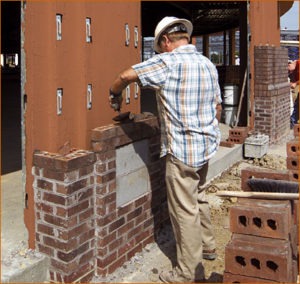 A masonry wall goes up over sheathing coated with PROSOCO R-GUARD, a water-based, fluid-applied air- and water-resistive barrier. Photo courtesy of PROSOCO[/caption]
A masonry wall goes up over sheathing coated with PROSOCO R-GUARD, a water-based, fluid-applied air- and water-resistive barrier. Photo courtesy of PROSOCO[/caption]
Keith Lolley, VP for Advanced Building Products Inc. in Springvale, Maine, points out that proper flashings are needed with air barriers.
"Remember, air barriers are not through-wall flashings and do not take the place of through-wall flashings," Lolley says. "Installing a metal drip edge with an air barrier-type product in a flashing application will heat up the air barrier, causing it to drool and stain the surrounding masonry. Current rubberized asphalt air barriers are not UV resistant."
Advanced Building Products recently invented a non-asphaltic copper flashing, Copper Sealtite 2000, that's UV resistant and compatible with all air barrier systems for use at the base of walls, over doors and windows, and any other obstruction, he says.
Side Stories:
Return to Table of Contents